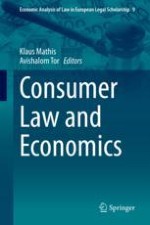2021 | OriginalPaper | Chapter
Limits to Behavioural Consumer Law and Policy: The Case of EU Alcohol Labelling
Authors : Hanna Schebesta, Kai Purnhagen
Published in: Consumer Law and Economics
Publisher: Springer International Publishing
Activate our intelligent search to find suitable subject content or patents.
Select sections of text to find matching patents with Artificial Intelligence. powered by
Select sections of text to find additional relevant content using AI-assisted search. powered by
